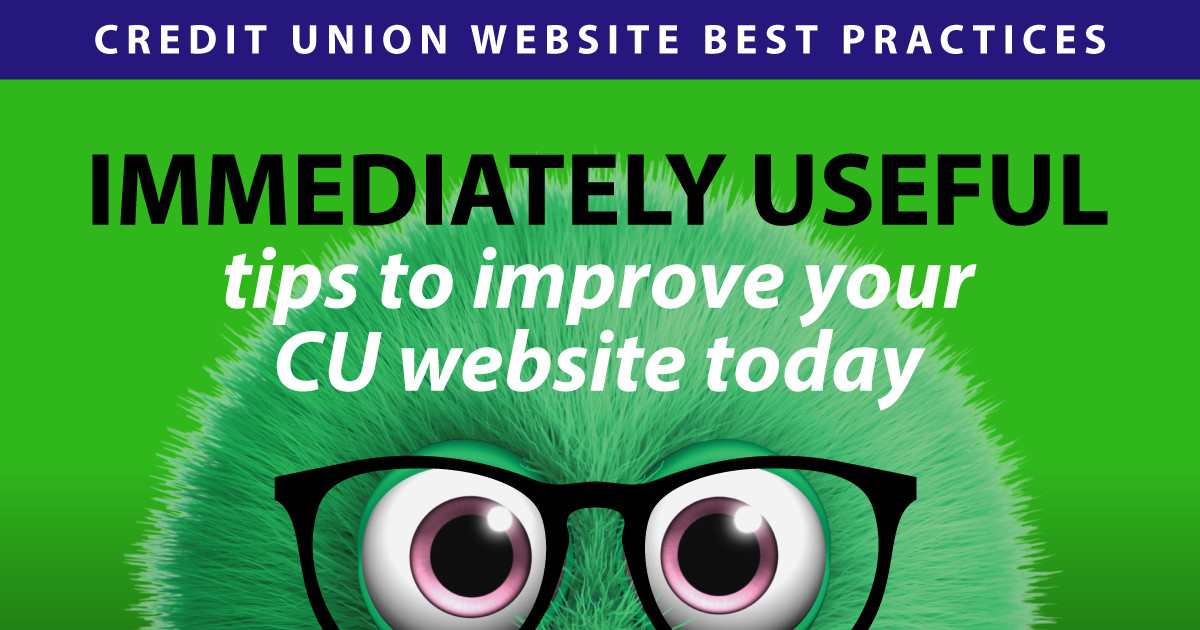
10 things that need to be on your website (but probably aren’t)
We’ve built websites for credit unions for a long time, so we have a lot to say about them. One of our favorite things to say is, “Credit union websites are weird.” (In marketing weird is good, so don’t overthink it.)
People visit their credit union’s website for different reasons than other websites. They’re not ordering some new shoes or eyeglasses. Credit union website users have goals and questions that your average SEO guru might not expect.
We could talk about this subject for literal hours, but that would be information overload. Instead, we want to give you something that’s immediately useful and can improve your CU website today, as in right now. So here’s our list of ten things that need to be on your credit union’s website (but probably aren’t):
1. How to apply for a loan
We still haven’t seen a step-by-step guide to successfully applying for a loan. People aren’t born knowing how to do this, and it’s incredibly discouraging when you get it wrong.
Creating this means explaining what information you will need to find, why the CU is asking all this nosy stuff, what all the jargon means, etc. Also, make sure the know who to call with questions. Put the phone number on the same page!
2. How to open an account & what to bring
Much like applying for a loan, people get hung up where you might not expect them to. When you work at a credit union, you see this stuff every day. Your members might not think about opening a bank account for decades at a time.
In other words, make sure you explain clearly and accurately the actual process of opening an account. Do this before they get dumped into the online app!
3 & 4. How to sign up for Online Banking & reset your Password
Okay, yes, we combined these two suggestions. Which is cheating, but only a little bit.
Use lots of screenshots from your actual systems to answer the top OLB (online banking) questions. Don’t use the provider’s generic video for this; it looks different and this is very confusing.
If you use videos, make them super-short and focused on one question at a time with no fluff. As a bonus, a series of short videos is excellent social media fodder.
5. A real preview of your mobile app for non-members
Potential members young and old want to get a real live look at your app, and what it’s like to use. They’re doing their due diligence. Why not give it to them?
This preview should be screenshots at least, but even better as a video. Want to really impress everyone? Make a test system and give them some firsthand experience.
Most CU’s just don’t offer this. You want to set potential members up for success, and a highly rated app will be far more successful.
6. Your city(s) and state on every page
Google, and potential members, need to know where you are, so city and state are the minimum.
It’s honestly surprising how often this is missing. Sure, people can find this info with some digging, but why would you turn such an easy fix into a problem for visitors?
7. A library of info for struggling members
Lots of CUs have some financial education materials on their site or blog somewhere. Unfortunately, a lot of it is “canned” material and very few CUs have anything that stands out.
Our suggestion? Don’t be afraid of “negative” topics. The world doesn’t need another generic article on retirement planning that features that same silver-haired couple on a beach. They’re fine, they’ve got it made.
The world DOES need real, trusted advice on navigating a layoff or medical bills. Most people don’t know what to do after a divorce, death, or bankruptcy. Giving your members some guidance could make a real difference.
8. Routing number, phone number, text, email on every page
Nothing loses potential members faster than being unable to reach you. You should have multiple contact methods — that you ACTUALLY respond to quickly — and put them on every page.
9. Real FAQs
Too many FAQs are really QWWPWA = Questions We Wish People Would Ask. And yes, people can tell the difference.
Not sure what to put on your FAQs? Ask your call center, or your tellers on the front line. They’re the ones speaking with real people and helping them with their problems. You might be surprised by what they say.
10. A working, natural-language internal search engine
We cannot overstate the importance of an internal search engine, or the impact it will have on your members’ experience.
People don’t want to sort through your navigation. They’d rather just search for it. This is especially true on mobile.
And once members find out your internal search engine actually works, they’ll keep using it. And using it. And using it. And you’ll get a wealth of great data.
—
See anything on this list that surprised you? Have a suggestion for something we missed? Let us know!
Want more of this? See more of our credit union website best practices.
This post was updated 4/22/25
- 10 things that need to be on your website (but probably aren’t) - April 22, 2025
- In Case You Missed It – 3.12.25 - March 11, 2025
- Three young members you can help in 2025 - January 14, 2025
